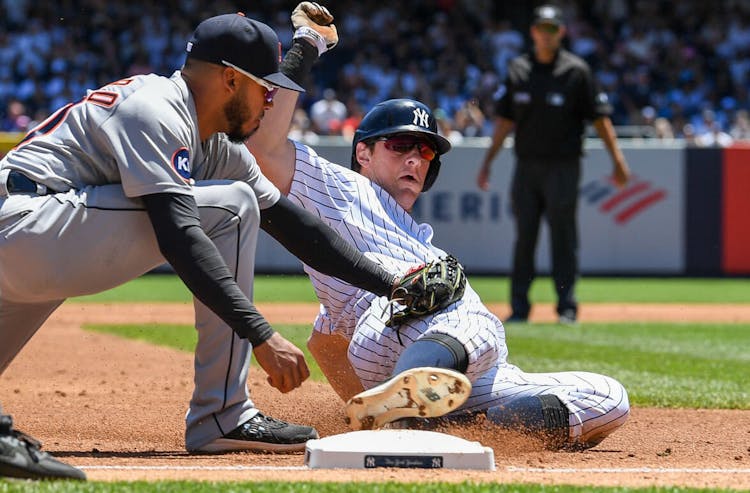How Do You Play Baseball: Beginner’s Guide and Rules
Baseball is played by two teams that take turns batting and fielding. The objective is to score runs by hitting a pitched ball and running around four bases.
A beloved pastime, baseball captivates fans with a blend of strategy, skill, and athleticism. Known as America’s national pastime, the game unfolds on a diamond-shaped field where precision and teamwork are key. Whether at a local park or a major league stadium, each match tells a story infused with suspense and excitement.
Embraced by millions, baseball’s rules and gameplay are straightforward yet offer profound depth for enthusiasts. Players and spectators alike cherish the ritualistic and often dramatic competition, making it not just a sport but a cherished cultural tradition. With each pitch, hit, and home run, baseball continues to win hearts and offer a thrilling spectacle.
Introduction To America’s Pastime
Introduction to America’s Pastime unveils the exciting world of baseball, a game woven into the very fabric of American culture. Often referred to as America’s favorite pastime, baseball carries with it a rich history and a deep reservoir of cherished memories. From the crack of the bat to the roar of the crowd, baseball is more than a sport—it’s a celebration of teamwork, tradition, and the triumph of the human spirit.
The Essence Of Baseball
Baseball showcases the beauty of a simple yet strategic game. A team sport played with a bat, a ball, and gloves, it pits two teams against each other. Nine innings make up a standard game, with teams alternating between offense and defense. The objective is clear: score more runs than the opponent. Players hit the ball and navigate a diamond-shaped circuit of bases to achieve this goal. Teams work in unison, revealing the essence of baseball as cooperation, strategy, and skill harmoniously blend on the field.
Why Baseball Captivates Millions
Baseball holds a special place in the hearts of millions for its ability to create timeless moments. Excitement builds with each pitch and swing. Fans bond over shared loyalties and the thrill of nail-biting finishes. From little league games to major leagues, the inclusivity of the game sparks joy across ages and communities. Its unpredictability and the pursuit of perfect plays keep aficionados coming back, relishing in the game’s enduring allure.
Basic Rules And Objectives
Baseball is a game with simple objectives but complex rules. The goal is to score more runs than the opposing team. Two teams take turns batting and fielding.
Each game consists of nine innings. Each inning has a top and bottom half. The batting team tries to score runs while the fielding team aims to get three outs.
Scoring Runs and Winning GamesScoring Runs And Winning Games
Players score runs by hitting the ball and running across four bases. A complete circuit scores one run.
- Hitting the ball and reaching at least first base without getting out.
- Advancing between bases on hits, walks, or errors.
- Reaching home plate before three outs are recorded.
The team with the most runs at the end of nine innings wins. Extra innings are played if the game is tied.
Three Strikes, You’re OutThree Strikes, You’re Out
A strike is when a batter swings and misses a ball or does not swing at a ball in the strike zone. Three strikes mean the batter is out.
| Term | Definition |
|---|---|
| Strike Zone | An area over home plate between the batter’s knees and mid-chest. |
| Foul Ball | A ball hit outside the field lines. It counts as a strike unless the batter already has two strikes. |
| Batter’s Count | The number of balls and strikes currently against the batter. |
When the batter accumulates three strikes, they are out. The team continues batting until three outs are made.
Setting The Field
Before a baseball game starts, setting up the field is crucial for smooth play. This setup is like a chessboard where every position matters. The two main areas to focus on are the pitcher’s mound and the configuration of the bases and outfield.
Pitcher’s Mound To Home Plate
The pitcher’s mound is a raised area in the center of the infield. This is where the pitcher stands to throw the ball to the batter. The top of the mound is 60 feet 6 inches away from home plate. This distance is important for pitch speed and hitter reaction time. The mound is also 10 inches higher than home plate. This gives pitchers an advantage when throwing the ball.
Bases And Outfield Explained
The bases form a diamond in the infield, each 90 feet apart. Running from home plate to first base, then to second, third, and back to home plate equals one run scored. The area beyond the infield is the outfield. It doesn’t have a set size, but it’s divided into three sections:
- Left Field: To the batter’s left
- Center Field: Directly behind second base
- Right Field: To the batter’s right
Setting up the field with precise measurements ensures fair play. By understanding the layout, players can better strategize and fans can follow the game easily. The field setup is as essential as the game’s rules.
Essential Equipment
Stepping onto the diamond requires more than just skill and passion. The right equipment is crucial for playing baseball effectively and safely. Let’s gear up and discover what essentials you’ll need to hit home runs and make those game-saving catches.
Gloves
In baseball, gloves are a player’s best friend. Each position on the field has a specific type of glove:
- Catchers use a padded mitt to catch fast pitches.
- First basemen have a longer, curved glove for scooping ground balls.
- Infielders prefer smaller gloves for quick plays.
- Outfielders use larger gloves to catch fly balls.
Choose a glove that fits snugly and is comfortable. The leather should be high-quality for durability.
Bats
Bats come in different materials and sizes:
| Material | Advantages |
|---|---|
| Wood | Classic feel, Major League requirement |
| Aluminum | Lightweight, good for beginners |
| Composite | Reduced vibration, enhanced sweet spot |
Measure the bat’s length to your height to ensure a good fit. A well-sized bat improves swing and control.
Balls
Baseballs are small, hard, and covered in leather. They feature:
- A cork core for bounce and resilience.
- Red stitching for grip and pitch control.
- Durable hide covering to withstand hits.
Regularly inspect balls for wear and tear. Consistent performance comes from quality balls.
Uniforms And Protective Gear
An official uniform consists of:
- A hat to shield eyes from the sun.
- A jersey representing the team.
- Pants that are sturdy for slides.
- Cleats for traction while running.
Protective gear is vital:
- Helmets keep batters safe at the plate.
- Catcher’s gear includes a helmet, shin guards, and chest protector.
- Sliding pads protect legs during base running.
- Elbow and shin guards shield against pitches.
Select gear that fits properly to ensure maximum protection and mobility during the game.
Player Positions And Roles
Player positions and roles are the spine of the baseball game. Let’s understand each position and the unique roles they play in winning the game.
Infielders And Outfielders
Infielders guard the area within the bases. Outfielders cover the vast ground beyond the bases. Each player has a crucial part to play.
Four infield positions include:
- First Baseman – Catches throws from other infielders.
- Second Baseman – Covers second base and assists first.
- Shortstop – Handles balls hit between second and third.
- Third Baseman – Fields balls hit down the third base line.
Three primary outfield positions:
- Left Fielder – Plays the left section of the outfield.
- Center Fielder – Commands the middle outfield zone.
- Right Fielder – Covers the right portion of the outfield.
Pitcher And Catcher Dynamics
The pitcher and catcher work together closely. They form the game’s battery.
| Pitcher | Catcher |
|---|---|
| Throws the baseball to the catcher. | Calls for pitches and catches them. |
| Must have strong throwing skills. | Needs quick reflexes for catches. |
| Strategizes to outwit batters. | Acts as the field’s leader and strategist. |

Credit: www.covers.com
Understanding The Gameplay
Welcome to the energetic world of baseball, a game packed with excitement and strategy. Understanding the gameplay is essential for both enthusiasts and new fans alike. Let’s dive into the core of baseball mechanics.
Innings And Turns At Bat
Baseball is divided into sections called innings. Each game typically has nine innings. An inning consists of two halves: the top and the bottom. In each half, one team bats while the other team defends. The teams switch roles after three outs are made. Points, known as runs, are scored by batting teams during their turn at bat when players succeed in circling the bases and reaching home plate safely.
The Lifecycle Of An At-bat
An at-bat is an individual player’s turn batting against the pitcher. The lifecycle of an at-bat progresses through various outcomes:
- Pitch: The pitcher throws the ball towards home plate.
- Swing or Hold: The batter decides to swing at the pitch or wait for another.
- Hit or Miss: If the batter hits the ball, they run towards first base. If not, they either strike or prepare for the next pitch.
- Outcome: The at-bat continues until the batter hits the ball and is either out or safely on base, walks to base on balls, or gets hit by the pitch.
This sequence repeats each time a new batter steps up to the plate.
Strategies And Tactics
Mastering the game of baseball demands more than just basic skills. It requires a deep understanding of various strategies and tactics. A smart approach can turn a good team into a great one. Both offensive plays and defensive positioning are critical chapters in the playbook of baseball. Let’s dive into the tactical depths of baseball and see what makes a winning strategy.
Offensive Strategies
Teams on the offense aim to score runs by outsmarting the defense. Below are key strategies:
- Bunting: Hitters lightly tap the ball to advance base runners.
- Stealing Bases: Runners take a leap towards the next base to surprise the opponents.
- Hit and Run: A runner starts before the hitter strikes, creating momentum.
Defensive Plays And Positioning
A solid defensive setup can shut down the opponent’s offense. These are the fundamentals:
| Defensive Position | Key Responsibility |
|---|---|
| Pitcher | Controls the game’s pace and tries to strike out the hitter. |
| Catcher | Acts as the field general, guiding pitchers and watching base runners. |
| Infielders | Defense against ground balls and cover bases for outs. |
| Outfielders | Catch fly balls and back up infield plays. |
Each position has a unique role in creating a dynamic defense that reacts to the offense’s moves. Working together, these players form an impenetrable line against scoring threats.

Credit: m.youtube.com
Rules For Base Running
Knowing the Rules for Base Running is crucial in baseball. Players run bases to score runs. But there are special rules. They make the game fair and exciting. Let’s explore these essential rules.
Stealing Bases
Stealing bases keeps the game thrilling. A runner tries to reach the next base before the ball. Here’s what to remember:
- A runner can steal after the pitch.
- The ball must be live (in play).
- Time outs or fouls stop base stealing.
Timing and speed are key. The runner watches the pitcher. They run fast when the pitcher throws the ball.
Tagging Up And Scoring
‘Tagging up’ means going back to a base during a fly ball. Once the ball is caught, runners can dash to the next base. Here’s the right way:
- Stand on the base until the catch.
- Run after the ball is in a glove.
- Touch each base in order.
- Reach home plate to score a run.
This rule stops early running. It makes sure outfielders have a chance. Scoring a run feels great. But it must be done right.
Common Penalties And Foul Play
Learning baseball rules is crucial for fair play. Certain actions can lead to penalties. Understanding these can help players stay in the game. Let’s explore some common penalties and avoidable mistakes in baseball.
Balks
When a pitcher makes an illegal motion, umpires call a balk. This can advance runners on base. Balks can be confusing even for seasoned players. Here are key points to help identify a balk:
- Starting a pitch and not completing it.
- Throwing to a base without a proper foot movement.
- Pretending to throw the ball when not on the mound.
Interferences
Interferences happen when a player illegally affects play. It often leads to the batter or runner gaining an advantage. Two main types of interference to watch for include:
| Type of Interference | Description |
|---|---|
| Batter Interference | Occurs when the batter hinders the catcher from making a play. |
| Runner Interference | Happens if a runner disrupts a fielder attempting to make an out. |
Obstructions
Unlike interference, obstruction is on the defense. It occurs if a fielder gets in a runner’s path without possessing the ball. Note these tips to avoid obstruction:
- Avoid blocking the base paths.
- Give clear passage to runners unless making a play.
- Stay alert to where runners are on the field.
Avoiding Common Mistakes
Playing smart baseball means avoiding errors and penalties. Here’s how players can stay on top of their game:
- Learn the rules and apply them consistently.
- Communicate clearly with teammates during plays.
- Practice regularly to improve game knowledge and instincts.

Credit: faroutmagazine.co.uk
Getting Started With Practice
Welcome to the exciting world of baseball, a sport filled with thrills, strategies, and teamwork. Before you can hit home runs or make stunning catches, you must start with practice. For newcomers, grasping the basics through repetition is key to developing game-changing skills. Let’s dive into how you can set the foundation for your baseball journey.
Drills For Beginners
Starting with drills is essential for mastering the fundamentals. Structured practice sessions build muscle memory and enhance understanding of the game. Here are some beginner-friendly drills:
- Catching and Throwing: Pair up and practice tossing the ball back and forth, focusing on form and accuracy.
- Batting Tee: Use a batting tee to practice your swing and improve hand-eye coordination.
- Ground Ball Drills: Work on fielding by rolling or hitting ground balls to each other.
- Base Running: Learn the paths and practice swift turns and slides around the bases.
Joining A Local League
After getting a handle on the basics, consider joining a local league. This is a great way to apply your skills and learn from competition. Here’s a simple guide to get started:
- Research local teams and leagues suitable for your age and skill level.
- Attend tryouts or sign up for beginner-friendly teams that focus on player development.
- Commit to regular practice and games to steadily improve your performance.
Frequently Asked Questions On How Do You Play Baseball
How Do You Score In Baseball?
In baseball, a player scores by safely reaching home plate after advancing through first, second, and third base. This can happen due to hits, walks, or errors by the opposing team.
How Do You Explain Baseball To A Child?
Baseball is a team sport with two main roles: batting and fielding. Players hit the ball and run bases to score, while the opposing team tries to catch the ball and tag runners out. The team with the most runs after nine innings wins.
How Do You Explain Baseball To Someone?
Baseball is a team sport where two teams take turns batting and fielding. The batter hits a pitched ball and runs the bases to score runs, while the fielding team tries to get the batters out. The team with the most runs after nine innings wins the game.
Conclusion
Stepping up to the plate in baseball is more than a game; it’s a test of skill, strategy, and teamwork. Remember, practice makes perfect, whether you’re swinging for the fences or making that game-saving catch. Embrace the fundamentals we’ve covered, gather your team, and get ready to hit a home run.
Now, go enjoy America’s beloved pastime and play ball!



